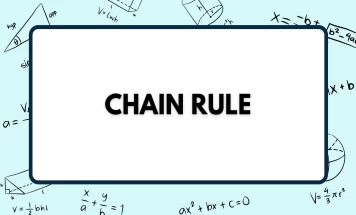Introduction to the Power Rule
Derivative is a fundamental concept of calculus that deals with the rate of instantaneous change in a function due to an independent variable. To calculate this rate of change, the derivative is further classified into various rules. The power rule is one of these rules that are mostly used. It is used to differentiate algebraic functions with powers.
The power rule is an important method in differentiation, because it helps to differentiate algebraic functions.
Understanding the Power Rule of Differentation
The derivative is the rate of instantaneous change in a quantity with respect to a specific condition or variable. The power rule is a technique of finding the rate of change of a function with some power. In other words, it is used to calculate the rate of change of algebraic expressions such as xn. It is also known as exponent rule.
The power rule for derivative can be defined as:
“The derivative of a function can be calculated by multiplying the coefficient of power with the function and reducing its power by 1.”
For example, the derivative of cos^2x is equal to -2cos x sin x, which can be easily obtained using the power rule derivative.
Power Rule Formula
Mathematically, the power rule formula for a function f(x) = xn is expressed as;
\[ f'(x) = n \cdot x^{n-1} \]
Where, n is a real number. It can vary for different functions. The power rule formula is also used to differentiate any function like fractional, negative power, trigonometric, exponential, and logarithmic function. Let’s discuss the following examples to find the derivative of a function by using the power rule. Before this, let’s understand how to differentiate a function by using the power rule.
How to apply the power rule of derivatives?
The power rule formula of derivative can be applied to find the rate of change in a power function. There are some simple steps to apply this rule. These are:
- Write the expression of the function for which you want to calculate the derivative.
- Identify the function. If the function is a power function i.e. an expression with some power like xn.
- Now apply the derivative on the expression and use the power rule.
- To apply the power rule, multiply the power with the function and reduce the power by 1 i.e. if the power is n, after reduction it will be n-1.
- Simplify the expression if needed.
By using the above steps, we can find the derivatives in the following examples.
Derivative of power function examples
Power rule example 1
The derivative of tan square can be calculated by using the power, which is written as;
\( f(x) = \tan^2x \)
Derivative with respect to \( x \)
\[ f'(x) = \frac{d}{dx} (\tan^2x) \]
Using the power rule for differentiation, where
\( \frac{d}{dx}(x^n) = n \cdot x^{n-1} \cdot \frac{d}{dx}(x) \)
\[ f'(x) = 2 \tan x \cdot \frac{d}{dx} (\tan x) \]
Since the derivative of \( \tan x \) is \( \sec^2x \)
\[ f'(x) = 2 \tan x \cdot \tan x \sec^2 x \]
Simplifying:
\[ f'(x) = 2 \tan^2 x \sec^2 x \]
So, the derivative of \( f(x) = \tan^2x \) with respect to \( x \) is \( f'(x) = 2 \tan^2 x \sec^2 x \)
Since we have calculated the derivative of tan squared by using the power rule.
Let’s discuss another example by using the power rule. In the following example, we will also discuss the visual representation of the rate of change in the function.
Power Rule Example 2
The derivative of y = x^2 can also be calculated by using the power rule formula. For this, we must first apply the derivative on both sides of the equation.
Given function: \( y = x^2 \)
Derivative with respect to \( x \)
\[ \frac{dy}{dx} = \frac{d}{dx} (x^2) \]
Using the power rule for differentiation, where \( \frac{d}{dx}(x^n) = n \cdot x^{n-1} \cdot \frac{d}{dx}(x) \)
\[ \frac{dy}{dx} = 2x^{2-1} \cdot \frac{d}{dx}(x) \]
Simplifying the derivative of \( x \)
\[ \frac{dy}{dx} = 2x \]
So, the derivative of \( y = x^2 \) with respect to \( x \) is \( \frac{dy}{dx} = 2x \)
If we measure the rate of change in y=x^2 at every point, the following curve will be obtained.
The graph represents the rate of change in x^2 at every point in its domain. The equation y=x^2 is known as the equation of a parabola. Using the power rule calculus of derivatives makes it easy to find the rate of change in y. The derivative graph calculator can be also used to find the graphical representation of a function’s derivative.
Applying the Power Rule by using Calculator
The derivative of a power function can be also calculated by using a derivative calculator online. It is an online tool to differentiate power functions by using the power rule formula. You can find it online by searching for a derivative calculator. For example, to calculate the derivative of ln squared x, the following steps are used by using the dy/dx calculator.
- Write the expression of the power function in the input box such as, ln^2x.
- Choose the variable to calculate the rate of change, which will be x in this example.
- Review the input so that there will be no syntax error in the function.
- Now at the last step, click on the calculate button. This step will provide the derivative of ln squared quickly and accurately which will be 2ln x/x.
Comparison between power rule and Difference rule
The comparison between the power and difference rules can be easily analysed using the following difference table.
Power Rule | Difference Rule |
The power rule calculus is used to differentiate a polynomial whose degree is n. | The difference rule is used to differentiate the difference between two functions. |
The power rule is defined as; \[ \frac{d}{dx} (x^n) = nx^{n-1} \] | The difference rule is defined as; \[ \frac{d}{dx} \left[ f(x) - g(x) \right] = f'(x) - g'(x) \] |
The power rule can be used along with the difference rule to find the derivative of a function. | The difference rule can also be used along with the power rule to find the derivative. |
Conclusion
The power rule is a calculus method to differentiate an algebraic expression with nth degree. In conclusion, this rule is a fundamental technique in calculus. It is because algebraic expressions cannot be differentiated without the power rule. It can calculate the derivative of any polynomial functions and the functions that have an exponent with a real number.






